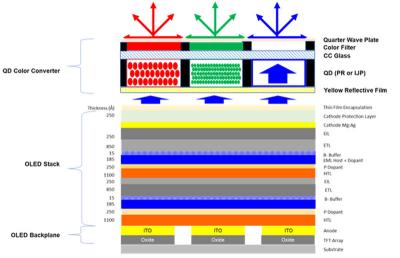In October 2019 Samsung Display formally announced its decision to invest $10.85 billion in QD-OLED TV R&D and production lines. The company is already starting to produce prototypes, and is on track to start mass production in Q3 2021.

But SDC is facing a problem it probably did not anticipate - Samsung Electronics is hesitant about the adoption of QD-OLED panels, and may not ship QD-OLEDs in 2021 - or maybe even at all. Apparently Samsung Electronics wants to focus on microLEDs for next-generation displays as it finds QD-OLED TVs to be not bright enough - and also because it suffers from burn-in issues.
Samsung Display is now looking for other customers, and one of these is China's TCL - which has reportedly decided to order QD-OLED panels. TCL plans to introduce its first QD-OLED TV, a 65" one, in IFA 2021 (September 2021). According to earlier reports, by the way, SDC also shipped QD-OLED prototypes to Sony and Panasonic.
This is a somewhat strange development - Samsung Electronics owns a majority share (over 80%) of Samsung Display which decided to invest almost $11 billion in QD-OLED technology while its parent company does not approve of this technology for its own products.
Omdia expects Samsung Display to produce 55-inch, 65-inch, 78-inch and 82-inch QD-OLED panels. It will also adopt the technology to produce 27-inch and 32-inch 8K gaming monitors. It could be that Samsung Electronics is mostly interested in QD-OLEDs for monitors, but it is likely that the vast majority of SDC's QD-OLED production capacity will be devoted to TV panels.
In October 2019 Samsung Display formally announced its decision to invest $10.85 billion in QD-OLED TV R&D and production lines. Samsung is converting its LCD production line in the L8 fab in Tangjong, Korea to QD-OLED production. The Tangjong line will be converted from 125k monthly substrates of LCD production to 30k monthly QD-OLED substrates.
In the long run SDC plans to convert all its 8-Gen LCD lines (360,000 monthly substrates) to QD-OLED production (which will yield around 100,000 monthly QD-OLED substrates).

According to DSCC, Samsung's QD-OLEDs will offer several advantages compared to LG's current WRGB (four subpixels + color filters) system. Samsung will be able to use three sub pixels and only two emitting layers (LGD uses four), and so its stack will include 13 layers compared to 22 layers in LGD's TVs - which means fewer deposition stages, improved yields and lower material costs.
In fact, DSCC estimates that a square meter of QD-OLED production will require materials that cost around $26 - compared to almost $95 in a meter of WOLED production.

You can see DSCC's QD-OLED revenue forecast here - although they admit that as Samsung faces several technical challenges before it could launch commercial QD-OLED TVs, its forecast could be way off.
The two main challenges for QD-OLEDs, according to DSCC, are efficient blue OLED emitters (first-gen will likely use fluorescent emitters) and a good quantum-dot color converter (QDCC). Light management in this architecture is also a serious challenge.

